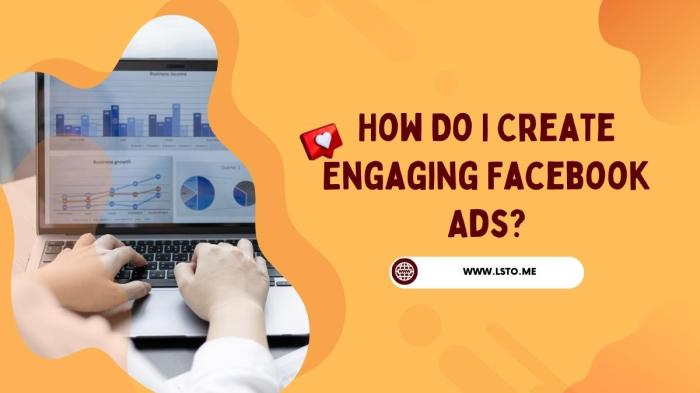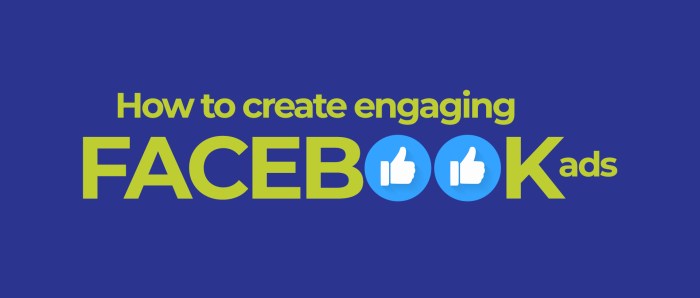Creating Engaging Facebook Ads sets the stage for reaching your target audience with compelling content and visuals that drive high engagement. Dive into the world of ad copy, visuals, CTAs, A/B testing, ad placement, budgeting, and optimization to master the art of Facebook advertising.
Understanding Your Audience: Creating Engaging Facebook Ads
Knowing your target audience is crucial before creating Facebook ads. By understanding the demographics, interests, and behaviors of your audience, you can tailor your ads to resonate with them effectively.
Demographics
- Demographics such as age, gender, location, and income level play a significant role in ad engagement. For example, a clothing brand targeting teenage girls will have different ad content compared to a retirement planning service targeting individuals over 50.
- Use Facebook Insights to gather data on the demographics of your audience. This tool provides valuable information on who is engaging with your content, allowing you to refine your targeting strategy.
Interests
- Understanding the interests of your audience is essential for creating relevant and engaging ads. For instance, a travel agency can target individuals interested in adventure travel with ads showcasing thrilling destinations and activities.
- Utilize Facebook Insights to analyze the interests of your audience. Look for common themes or preferences among your followers to create ads that resonate with their passions.
Behaviors
- Behaviors such as online shopping habits, device usage, and engagement with similar brands can influence ad engagement. For example, an e-commerce store can target users who have previously made purchases online with personalized product recommendations.
- Facebook Insights allows you to track the behaviors of your audience, such as their interaction with your page and posts. Use this data to refine your ad targeting and messaging for better engagement.
Compelling Ad Copy

Crafting ad copy that grabs attention is essential for driving engagement on Facebook. Here are some tips to help you create compelling ad copy that resonates with your audience:
Use of Persuasive Language and Storytelling
When writing ad copy, it’s important to use persuasive language that speaks directly to your audience’s needs and desires. Tell a story that evokes emotion and connects with your audience on a personal level. By using storytelling techniques, you can create a narrative that captures attention and drives engagement.
- Highlight the benefits: Focus on how your product or service can solve a problem or improve your audience’s life. Use language that emphasizes the value they will receive.
- Create a sense of urgency: Encourage action by using words like “limited time offer” or “act now.” This can create a fear of missing out (FOMO) and prompt immediate engagement.
- Include a strong call-to-action: Clearly tell your audience what you want them to do next, whether it’s to shop now, learn more, or sign up. Make it easy for them to take the next step.
Examples of Successful Ad Copy
Here are some examples of ad copy that drove high engagement on Facebook:
“Unlock the secret to glowing skin with our all-natural skincare products. Say goodbye to dull, tired skin and hello to radiance!”
“Join thousands of satisfied customers who have transformed their fitness journey with our revolutionary workout program. Start your transformation today!”
Eye-Catching Visuals

When it comes to creating engaging Facebook ads, using eye-catching visuals is crucial to capturing the attention of your target audience. High-quality images or videos can significantly impact the effectiveness of your ads, making them more appealing and memorable to viewers.
Selecting Visuals
Choosing visuals that resonate with your target audience is key to driving engagement and conversions. Consider the following best practices:
- Understand your audience: Research your target demographic to determine their preferences, interests, and visual style.
- Use authentic imagery: Opt for images that reflect real-life scenarios and evoke emotion to create a connection with viewers.
- Focus on relevance: Select visuals that are relevant to your product or service to ensure that they align with your brand message.
- Keep it simple: Avoid cluttered or overly complex visuals that may distract or confuse viewers. Opt for clean, visually appealing designs.
Impact of Design Elements
The colors, fonts, and design elements used in your ads can have a significant impact on ad engagement. Consider the following factors:
- Colors: Choose colors that align with your brand identity and evoke the right emotions in your audience. Different colors can convey different messages and influence viewer perception.
- Fonts: Select fonts that are easy to read and align with your brand’s tone and personality. Consistent font choices can help establish brand recognition.
- Design elements: Incorporate design elements such as shapes, patterns, and textures to enhance the visual appeal of your ads. Consistency in design can help create a cohesive brand image.
Call-to-Action (CTA) Strategies
In the world of Facebook ads, having a clear and compelling Call-to-Action (CTA) is crucial to driving user interaction and achieving your campaign goals. A well-crafted CTA can prompt users to take the desired action, whether it’s making a purchase, signing up for a newsletter, or downloading an e-book.
Examples of Effective CTAs
- “Shop Now”
-This CTA is effective for driving direct sales and encouraging users to make a purchase. - “Learn More”
-Ideal for providing additional information and engaging users who want to delve deeper into your product or service. - “Sign Up”
-Great for growing your email list and capturing leads for future marketing efforts.
Types of CTAs and When to Use Them
- “Buy Now”
-Use this CTA when you want to drive immediate conversions and encourage users to make a purchase. - “Subscribe”
-Ideal for growing your subscriber base and keeping users updated on new products or promotions. - “Get Started”
-Perfect for onboarding new users and guiding them through the initial steps of using your product or service. - “Download Now”
-Use this CTA when offering a free resource or content download to capture leads and provide value to users.
A/B Testing
A/B testing is a crucial strategy to optimize the performance of your Facebook ads by testing different elements to see which ones resonate best with your audience. By comparing two versions of an ad, you can gather valuable data to make informed decisions and improve your overall ad campaign.
Benefits of A/B Testing
- Identify what resonates with your audience
- Optimize ad performance
- Reduce ad spend by focusing on what works
- Gain insights to improve future campaigns
Setting Up and Analyzing A/B Tests
Step 1: Identify the element you want to test (headline, image, CTA, etc.)
Step 2: Create two versions of the ad with the only differing element
Step 3: Set up the A/B test in Facebook Ads Manager
Step 4: Allocate equal budget and audience size to each version
Step 5: Monitor the results and analyze the data
Key Metrics to Track During A/B Testing
- Click-through rate (CTR)
- Conversion rate
- Cost per conversion
- Engagement metrics (likes, comments, shares)
- Return on ad spend (ROAS)
Ad Placement and Targeting
In the world of Facebook advertising, ad placement and targeting play a crucial role in determining the success of your campaigns. By strategically selecting where your ads appear and who sees them, you can significantly impact ad engagement and ultimately drive better results for your business.
Custom Audiences
Custom audiences allow you to target specific groups of people based on their interactions with your business. This could include website visitors, email subscribers, or customers who have made a purchase. By targeting these custom audiences, you can tailor your messaging to be more relevant and personalized, increasing the chances of engagement and conversions.
- Utilize custom audiences to reach people who are already familiar with your brand and more likely to convert.
- Experiment with different messaging and offers to see what resonates best with each custom audience segment.
- Regularly update and refine your custom audiences to ensure you are targeting the most relevant groups of people.
Lookalike Audiences
Lookalike audiences are created by Facebook based on the characteristics of your existing custom audiences. This allows you to reach new people who share similar traits and behaviors with your current customers, expanding your reach and potentially driving more engagement.
Lookalike audiences can help you discover new potential customers who are likely to be interested in your products or services.
- Use lookalike audiences to expand your target audience while still maintaining relevance.
- Monitor the performance of your lookalike audiences and adjust as needed to optimize results.
- Combine lookalike audiences with other targeting options for a more comprehensive approach to reaching new customers.
Retargeting
Retargeting allows you to show ads to people who have previously interacted with your brand, such as visiting your website or engaging with your social media content. By staying top of mind with these individuals, you can encourage them to take the next step in their customer journey and increase overall engagement and conversions.
- Create specific retargeting campaigns tailored to different actions or behaviors of your audience.
- Use compelling messaging and offers to entice retargeted users to re-engage with your brand.
- Implement frequency caps to avoid overwhelming users with too many ads and ensure a positive user experience.
Budgeting and Bid Strategies
When it comes to creating engaging Facebook ads, setting an appropriate budget is key to maximizing your results. Your budget will determine how often your ads are shown, who sees them, and how much engagement you can expect. It’s important to strike a balance between spending enough to reach your audience effectively and not overspending on ineffective ads.
Different Bidding Strategies, Creating Engaging Facebook Ads
- Cost Per Click (CPC): With this strategy, you pay each time someone clicks on your ad. It’s a good option if you want to drive traffic to your website or landing page.
- Cost Per Impression (CPM): This strategy charges you based on the number of times your ad is shown, regardless of whether users engage with it. It can be useful for increasing brand awareness.
Optimizing Ad Delivery and Budget Allocation
- Set a daily or lifetime budget based on your overall advertising goals and the duration of your campaign.
- Monitor the performance of your ads regularly and adjust your budget allocation to focus on the best-performing ads.
- Consider using Facebook’s automatic bidding feature to optimize your ad delivery and reach the right audience at the right time.
- Test different bidding strategies to see which one works best for your specific campaign objectives and target audience.
Monitoring and Optimization
When it comes to creating killer Facebook ads, it’s not just about setting it and forgetting it. You gotta keep an eye on how your ads are performing and make adjustments to optimize them for maximum engagement.Monitoring ad performance metrics is crucial to understanding what’s working and what’s not. By keeping a close watch on key metrics like click-through rate, conversion rate, and cost per click, you can identify areas for improvement and make data-driven decisions to boost your ad performance.
Best Practices for Optimization
- Regularly review ad performance metrics to identify trends and patterns.
- Test different ad elements like headlines, images, and CTAs to see what resonates best with your audience.
- Use A/B testing to compare different ad variations and optimize for the best results.
- Adjust your targeting parameters based on the performance data to reach the right audience.
Examples of Adjustments
- Updating ad copy to highlight different product benefits or promotions.
- Switching out underperforming images for more eye-catching visuals.
- Tweaking your CTA to be more compelling and action-oriented.
- Increasing or decreasing your ad budget based on performance to maximize ROI.
